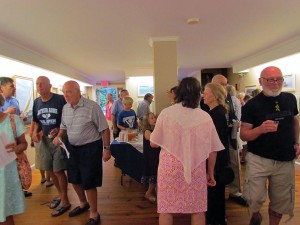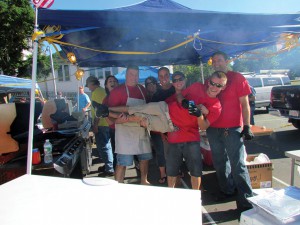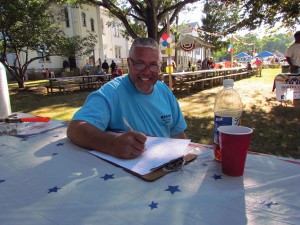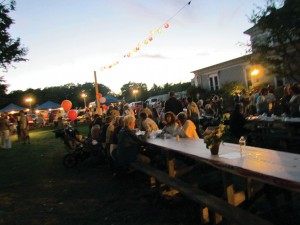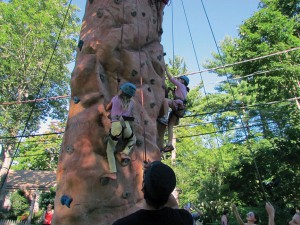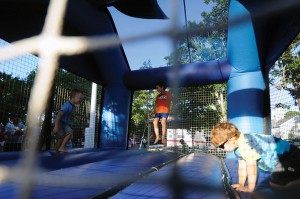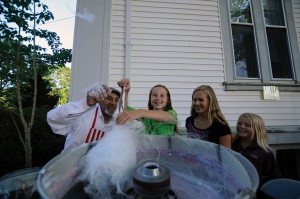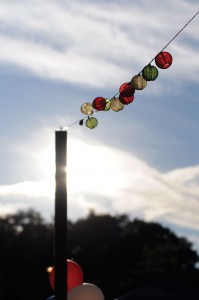Dear Reader, I was going to write to you about blueberries. I will get you that soon; however, not just yet because something has sent me down a detour bordered by … poison ivy!
All the years that I lived near cranberry bogs and wooded areas, taking my son and our dogs through piney forests and swampy bogs, I never worried about poison ivy. This was in spite of the fact that my dear son and apparently our big lug of a retriever got the evil oils all over themselves while fibbing that, “No, we didn’t go into the woods while you were working, Ma,” or, “No, I didn’t take the dog to the bog ditches,” even when the evidence was overwhelming, a dog covered stem to stern with soggy weeds and dripping fur. Hey, boys will be boys, right?
When my kid would find himself covered in poison ivy rash, I’d consult the doctor, pharmacists, and anyone with a homeopathic remedy in an effort to provide him with relief. However, I never experienced this misery firsthand. I was operating on the Mother-Principle versus the “been there done that” modus operandi.
For the past several years when I’ve played in my well-cultivated yard digging, moving plants and engaging in various other gardening activities, I’ve suffered from poison ivy’s evil capabilities. The early warning of small red welts erupt with the extraordinary power to torment the strongest mind with one thought and one thought alone: “Scratch. Come on, you know you want to … scratch me now.” This is followed in subsequent days with sometimes more patches of discomfort, followed by blisters, and finally, a slow healing process. Total elapsed time: Approximately 2.5 weeks – yes, weeks.
The first time it happened, the day after exposure, I thought I had bug bites that were so much more intense than any bug bites I had previously experienced. I chalked that up to simply living in a wooded area. When you’ve never had poison ivy reaction, you simply don’t know why those pesky bug bites are so very itchy. By day two, you realize something is terribly wrong, because not only are you still suffering from the original spot, more are sprouting before your very eyes.
My husband said during that first episode, “Sweetheart, that looks like poison ivy.”
“Poison Ivy!” was my indignant response. “I’ve never had poison ivy before – I don’t get it.”
“Well, you do now,” was his deadpan response. Hence, my education of all things poison ivy.
Let me stop here for a minute and say, much like giving birth (for those of us who have had that singular experience), reacting to poison ivy is something you forget about once you are over the horror. But only the really dumb would forget the basics. I now place myself squarely into the category of really dumb.
1. When working in gardens, wear long pants, long-sleeve shirts, clean gloves, and use clean garden tools. (I didn’t do this.)
2. Don’t touch your face while gardening. (I tried to do this.)
3. When done with the garden work, remove all clothing for immediate laundering and take a shower, being mindful to washing your body thoroughly to remove all poison ivy oils and slathering yourself with lotions chemically mixed to dilute the ivy oils. (I didn’t do this.)
I knew all of this stuff, but because I didn’t see any poison ivy plants, I figured I was safe. On day one, I was pretty cavalier. On day two, I knew I had some small spots of rash to deal with. On day three, I was a victim of my own stupidity.
I woke up to find my lips, face from the lower eyelids south through the collarbone, and chest covered with swollen, itching skin. I was horrified. I was pissed off. I was a broken New England gardener.
Having experienced a nasty episode two years ago, I knew I had to seek medical attention. Although treatments only moderately improve one’s life while riding out the storm of allergic reaction, they can reek on the human body. I didn’t care. I wanted them and I wanted them now. It was Sunday morning, however.
I went to the nice, new walk-in clinic in Fairhaven, where the nice receptionist and the nice nurse assured me I’d be seen soon. The minutes seemed like hours as the rash bloomed a lovely shade of rosy red and the skin cells screamed, “You are such a fool!” I didn’t know the facility had only been open for a week. But I figured my case, my reason for knocking on their door on a Sunday morning, was pretty run of the mill: gardening error 101 resulting in a horrific poison ivy reaction. It’s taught in every medical class and chronicled in all medical journals.
Their newness on the scene of urgent care facilities rendered the pleasant but befuddled staff, well, befuddled. There were plenty of folks seeking immediate care that didn’t want to or couldn’t afford the cost of going to a hospital emergency care center. I believe the medical industry and medical insurance providers (and yes, it is an industry, make no mistake about it) are encouraging people to go to urgent care facilities versus emergency room care for greater-cost efficiencies. The average urgent care visit is one-fourth the cost of visiting an emergency room.
My experience with both models has resulted in similar quality of care. So, if I develop poison ivy or cut my hand while washing holiday dishes (yeah, I did that last Christmas, resulting in seven stitches in the palm of my right hand), urgent care is okay by me. The wait time is about half of that which you’d experience in a hospital emergency room under normal circumstances. Today, it felt like I was a character in One Flew Over the Cuckoo’s Nest – I wanted to tear the sink off the wall and smash it threw the window, making an escape. These thoughts helped to distract me from my ever-swelling chin and nose, and the near total collapse of my otherwise calm, mature demeanor.
The nice, new walk-in clinic will work out fine for me in the future, and I ultimately got the service I was looking for, but the wait time was a bit excessive. No doubt, being customer service oriented means they will improve their turn-around times, especially for a Sunday morning rush which should be their peak demand time.
Back to the poison ivy theme; here are the do’s and don’t’s. From the Mayo Clinic website, www.mayoclinic.com/health/poison-ivy, we learn: Poison ivy rash is caused by a sensitivity to an oily resin called urushiol, which is found in the leaves, stems and roots of poison ivy, poison oak and poison sumac.
At least 50 percent of the people who come into contact with these plants develop an itchy rash. The most dangerous type of exposure occurs when the plant is burned and the smoke is inhaled, which can affect your lungs. Mild cases of poison ivy rash require no medical treatment. For more severe or widespread rashes – especially if it’s on your face or genitals – your doctor may suggest taking corticosteroid pills, such as prednisone, for a few weeks.
It now seems my yard is a hot bed for poison ivy. Yet after checking out some websites, I’m thinking poison oak and poison sumac might also be lurking around waiting to upset the tender equilibrium that is my allergic reaction physiology.
The FDA offers the following at www.fad.gov/forconsumers: Recognizing Poison Ivy, Poison Oak and Poison Sumac.
Poison Ivy: Found throughout the United States except Alaska, Hawaii and parts of the West Coast. Can grow as a vine or shrub. Each leaf has three glossy leaflets with smooth or toothed edges. Leaves are reddish in spring, green in summer, and yellow, orange or red in fall. May have white berries.
Poison Oak: Grows as a low shrub in the eastern United States, and in tall clumps or long vines on the Pacific Coast. Fuzzy green leaves in clusters of three are lobed or deeply toothed with rounded tips. May have yellow-white berries.
Poison Sumac: Grows as a tall shrub or small tree in bogs or swamps in the Northeast, the Midwest, and parts of the Southeast. Each leaf has clusters of seven to 13 smooth-edged leaflets. Leaves are orange in spring, green in summer, and yellow, orange or red in fall. May have yellow-white berries.
Poison ivy and other poison plant rashes can’t be spread from person to person. But it is possible to pick up the rash from plant oil that may have stuck to clothing, pets, garden tools and other items that have come in contact with these plants. The plant oil lingers (sometimes for years) on virtually any surface until it’s washed off with water or rubbing alcohol.
The rash will only occur where the plant oil has touched the skin, so a person with poison ivy can’t spread it on the body by scratching. It may seem like the rash is spreading if it appears over time instead of all at once. But this is either because the plant oil is absorbed at different rates in different parts of the body or because of repeated exposure to contaminated objects or plant oil trapped under the fingernails. Even if blisters break, the fluid in the blisters is not plant oil and cannot further spread the rash.
Tips for prevention:
Learn what poison ivy, oak and sumac plants look like, so you can avoid them;
Wash your garden tools and gloves regularly. If you think you may be working around poison ivy, wear long sleeves, long pants tucked into boots and gloves;
Wash your pet if it may have brushed up against poison ivy, oak or sumac. Use pet shampoo and water while wearing rubber gloves. Most pets are not sensitive to poison ivy, but the oil can stick to their fur and cause a reaction in someone who pets them;
Wash your skin in cool water as soon as possible if you come in contact with a poisonous plant. The sooner you cleanse the skin, the greater the chance that you can remove the plant oil or help prevent further spread;
Use the topical product “Ivy Block” if you know you will come into contact with the poisonous plants. This FDA-approved product is available over the counter.
As I sit here writing to you, ashamed to go out in public given that my face is now swollen like a watermelon and my lips like fat earthworms quivering in the sun, you can bet my medicine cabinet now contains all of the chemicals for garden games that may include the uninvited weeds of poisonous predisposition. Truly an ounce of prevention is worth a pound of cure.
By Marilou Newell



